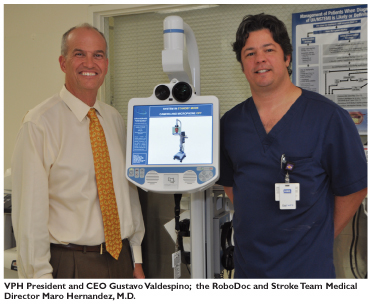By: Elise Kalfayan


Valley Presbyterian Hospital (VPH) earned The Joint Commission’s Gold Seal of ApprovalTM for certification as a Primary Stroke Center in June, announced VPH President and CEO Gustavo Valdespino. The recognition is one of many VPH has earned for high-quality care, innovative approaches, and better outcomes for patients.
VPH met all combined American Heart Association/American Stroke Association standards, including the critical requirement that a neurologist be available 24/7. A new telemedicine device named ‘RoboDoc’ by hospital employees makes it possible for physicians via their laptops or computers to examine and speak directly to patients, receive input from onsite medical teams, and advise on treatments and therapies. VPH is the only hospital in the San Fernando Valley with this technology.
“The overarching goal is a timely response, and RoboDoc makes that possible,” said Valdespino. “We’ve been working for quite some time to achieve this certification, and we are very proud.”
VPH is also a STEMI certified receiving center for heart attacks, its Neonatal Intensive Care Unit is certified by California Children’s Services for high risk pregnant women and their infants, and its emergency room is designated as an Emergency Department Approved for Pediatrics.
Based in Van Nuys, the hospital’s service area stretches from Canoga Park to Sun Valley. “VPH is the largest acute care provider in the Valley, seeing between 4500-4800 ER patients per month. The hospital also delivers the most babies, and has one of the largest neonatal care units,” said Mr. Valdespino. “Maternal and child health is a very strong point for the facility.”
VPH Vice President for Business Development Julie Reback noted, “Paramedics rarely divert patients from here to other hospitals because we have a lot of capacity.” Mr. Valdespino added, “That capacity is related to our investment in professional staff. Our contract provider, Emergency Medical Associates, has really taken the ER to the next level.”
The hospital’s unique ownership allows it to focus exclusively on the community. “We are the only free-standing, nonsectarian hospital in the area,” said Mr. Valdespino. “The Presbyterian name reflects the church’s donation of land for a medical center in the 1950s, but we are an independent facility. We are not distracted by shareholders or corporate ownership interests. Management and the board decide what it is we should do to serve the community, and we include employees, doctors, and nurses in our decision making.” Medical staff evaluate physicians for hospital certification, with final approval by the board.
VPH physicians have stepped up to address critical local needs. Vascular Surgeon Dr. George Andros brought the idea for an Amputation Prevention Center to the hospital’s attention and was instrumental in establishing it. “There are only 3-4 other programs like this in the entire country, and ours is the only one in Southern California,” said Mr. Valdespino. “VPH now hosts the international Diabetic Foot Conference each year, with attendees from more than 30 countries and VPH as the main sponsor.”
Reback cites the Center’s 96% limb salvage rate: “If someone has an amputation, statistics show that their quality of life declines dramatically. People go out of network, they are willing to take on additional costs, to seek second or third opinions from our Center.”
The Center’s success has led to a $20,000 Vons Foundation grant supporting another VPH telemedicine program using the iPad2 and iPod Touch. Country Villa, the state’s largest skilled-nursing facility owner and operator will test the technology as it obtains off-site physician consultations for patients.
The Valley Hip and Knee Institute, another VPH program, offers leading edge orthopedic procedures to “weekend warriors” with damaged joints, featuring less invasive treatment options with faster recovery times.
Mr. Valdespino, with more than 25 years of hospital management experience, was appointed to head VPH in September 2009, and is emphasizing investment in equipment, quality, nursing, and key certifications. “Our overarching mission is to provide the best care that we can to the community. Our greatest strength is that we are a community asset and committed to being there.”
Language issues are part of the hospital’s ongoing assessments. Valdespino is fluent in Spanish; 2/3rd of the hospital’s patients are Spanish speaking. “We certainly know which employees speak certain languages, and we have a translation service through AT&T we use to call for translation into any language.” Reback added that the hospital is looking into getting clinical staff trained in medical Spanish, and that its professionals represent a broad range of cultural and language backgrounds.
Expanded community outreach is on the VPH agenda, with a series of health fairs and a education program on stroke symptoms and treatments. “Timeliness around stroke and preventing its damage is related not only how fast you get to a hospital but how fast your family members recognize the symptoms of stroke,” said Valdespino. Reback is enthusiastic: “We are planning a stroke awareness day for this fall and assembling a panel of physicians and personnel to speak about signs and symptoms of stroke. We hope to partner with the American Heart Association and American Stroke Association and combine this with a direct mail campaign informing the
By Elise Kalfayan

|